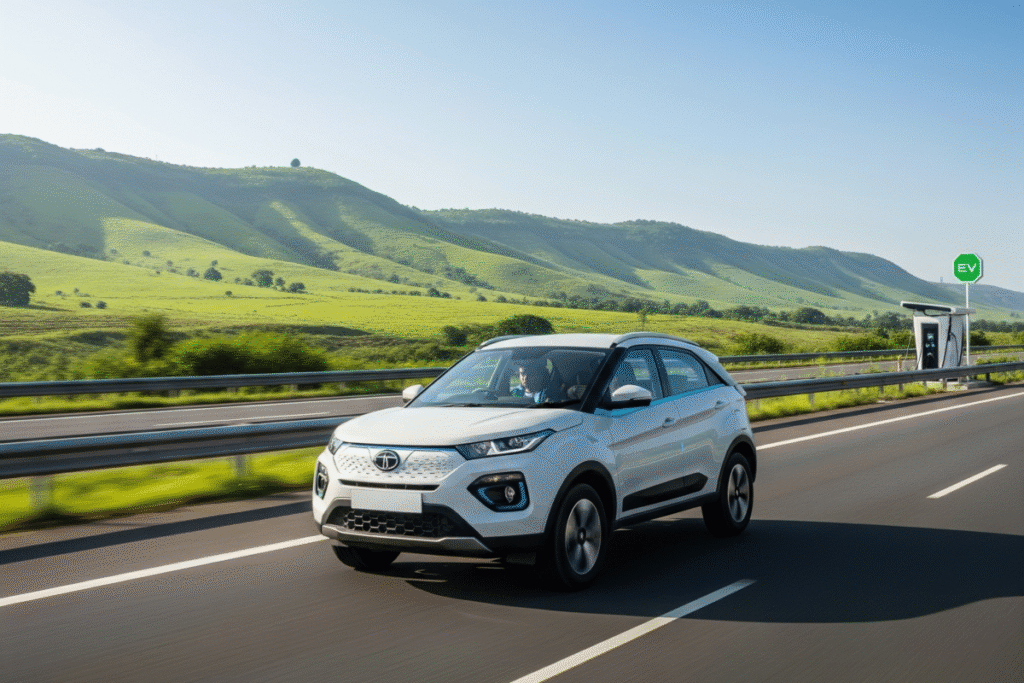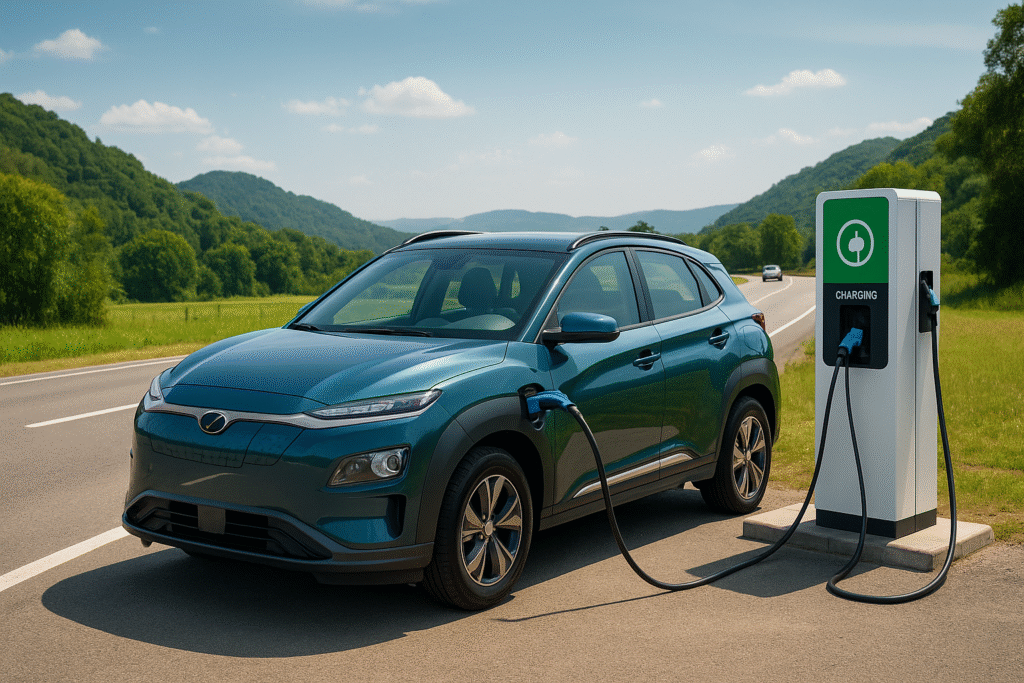As electric vehicles (EVs) become more common on Indian roads, the big question many potential buyers are asking is: Is an EV car good for long drive?
While EVs are undoubtedly efficient for daily commutes and city traffic, many drivers still hesitate when it comes to taking them on highways or weekend getaways. This guide explores the real-world performance of EVs on long journeys, including battery range, charging access, and daily usability in 2025.
If you’re still unsure about going electric, check out our guide on the top 7 advantages of choosing an EV.
What Is the Maximum Distance for an Electric Car Today?
Thanks to major improvements in EV battery technology, many electric cars in India can now cover between 300 to 500 km on a single charge. However, this figure can vary depending on driving conditions, weather, terrain, and speed.
Here’s a quick look at the claimed and real-world ranges of popular EVs in 2025:
| Model | Claimed Range (ARAI) | Estimated Real-World Range |
|---|---|---|
| Tata Nexon EV LR | 465 km | 330–350 km |
| MG ZS EV | 461 km | 350–370 km |
| Hyundai Creta Electric | 550 km | 420–450 km |
| BYD Seal | 650 km | 500–520 km |
While these figures are encouraging, it’s important to remember that actual range depends heavily on how and where you drive.
Does Driving Fast Drain the EV Battery Faster?
Yes, it does. Driving at high speeds—typically above 90 km/h—can significantly reduce battery efficiency and total range. This is because:
- Air resistance increases at higher speeds, forcing the motor to work harder.
- Regenerative braking is less effective on highways where you brake less often.
- High-speed driving discharges the battery faster, especially in dual-motor or performance EVs.
If you’re curious how regenerative braking helps in city or hilly driving, explore our detailed explainer on regenerative braking in electric cars.

Are there enough charging stations in India?
India’s EV ecosystem has made remarkable progress by 2025, especially in terms of public charging infrastructure. According to the Ministry of Power and data from key private players, there are now over 12,000 public EV charging stations across the country.
In urban centers, you can find a public charger every 2–4 km, and on highways, the government aims to install one every 25–30 km. This infrastructure growth has significantly improved EV confidence among Indian drivers.
Charging Time vs Fuel Stops: What to Expect
While petrol refills take 5 minutes, EV fast-charging can take 40–60 minutes to go from 10% to 80%, depending on the car and charger type.
To manage this:
– Plan charging during meals or rest stops.
– Avoid waiting for 100% — charging up to 80% is usually faster and more efficient.
– Maintain a 20% buffer to avoid range anxiety.
Which EV Cars in India Are Best for Long Drives?
Some electric cars are better suited for long-distance driving due to larger battery packs, faster charging capability, and ride comfort. Here are a few 2025 models ideal for highway travel:
- MG ZS EV – Long range, premium cabin, reliable fast-charging compatibility.
- Tata Nexon EV LR – Budget-friendly with improved range and wider support network.
- Hyundai Creta Electric – New 2025 SUV offering 450+ km real-world range and fast-charging support.
- BYD Seal – Extended range (up to 520 km real-world) and luxury features.
- Mahindra BE 6 – Futuristic SUV with ~500 km range and advanced driver-assist tech.
- Mahindra XEV 9e – Premium electric SUV with estimated 475–500 km range and long-trip comfort.
Also check out our latest news: Tata Harrier EV bookings cross 10,000 units as first production rolls out.
Can You Rely on EVs for Long Highway Drives?
Yes — with proper planning. In 2025, India’s EV charging infrastructure has grown rapidly, especially on popular highway routes. The government’s target of EV charging stations every 25 km along highways is slowly becoming a reality, with Tata Power, Statiq, and ChargeZone leading the way.
Use apps like:
- Tata EZ Charge
- PlugShare
- Ather Grid
- ChargePoint India
These tools help you locate and verify operational chargers, book slots, and estimate real-time wait times.
When Not to Take an EV for a Long Trip
While EVs are capable of long drives, they may not be the best option in certain cases:
- Unplanned or spontaneous trips without charger info.
- Rural areas or hilly terrain with no charging network.
- Limited time trips where every minute matters, and charging delays could impact schedule.
Is an EV Good for Daily Use?
Absolutely. In fact, EVs are arguably better suited for daily driving than ICE (internal combustion engine) vehicles, particularly in urban areas. Here’s why:
- Low running costs – Charging an EV at home costs around ₹1–1.5 per km.
- Minimal maintenance – No oil changes, fewer moving parts.
- Smooth driving – Instant torque, quiet cabins, and automatic gear systems.
Are Electric Cars Good for City Driving?
Yes, electric cars are perfect for city driving. With regenerative braking, stop-start efficiency, and compact turning radius, EVs are made for navigating Indian metro traffic.
Other benefits:
- Zero tailpipe emissions, helping reduce urban air pollution.
- Faster acceleration at low speeds, useful in congested traffic zones.
- Silent operation, offering a calm and comfortable ride experience.
Final Verdict: Is an EV Car Good for Long Drive?
Yes, an EV car is good for long drive — if you plan smartly, choose the right model, and make use of India’s growing EV infrastructure.
✅ Ideal for:
- Intercity drives on popular corridors (e.g., Delhi–Jaipur, Mumbai–Pune)
- Family road trips with breaks
- Eco-conscious travellers seeking savings
⚠️ Be cautious if:
- Your destination lacks verified chargers
- You’re tight on time or have unpredictable route changes
As of 2025, with longer-range EVs, faster chargers, and better route planning tools, long-distance EV travel in India is not only possible — it’s becoming enjoyable. Leading Indian and global automakers like Tata Motors, MG Motor India, and Mahindra Electric are playing a pivotal role in making EVs practical and appealing for both daily use and long drives.

